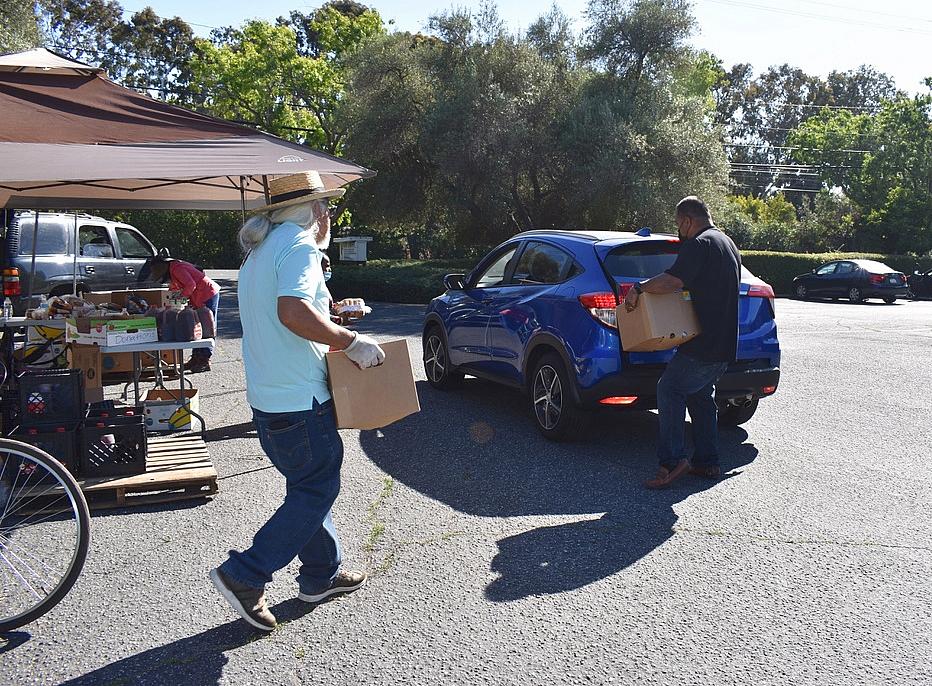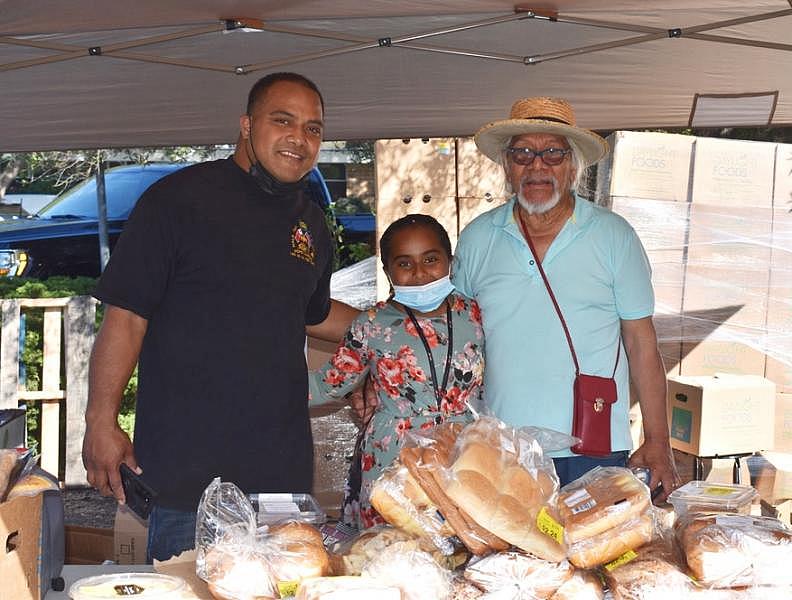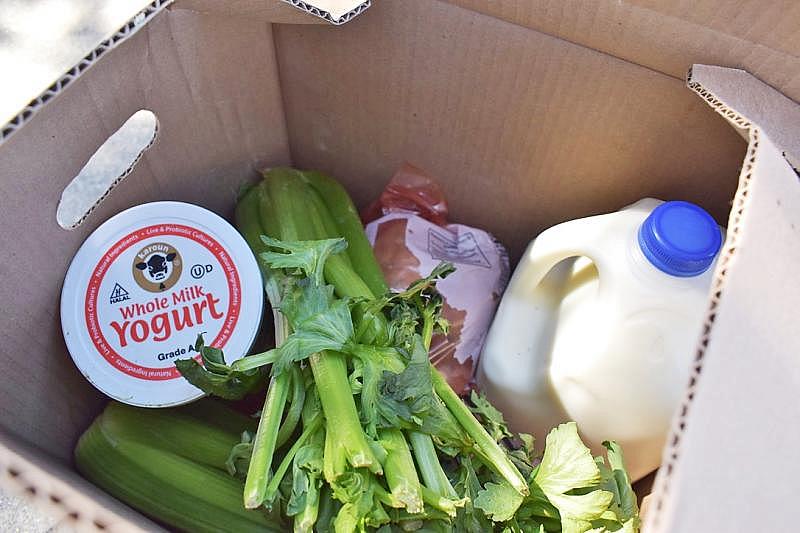Federal program that helps farmers during the pandemic is changing the local food landscape
This article was produced as a project by Kate Bradshaw for the USC Annenberg Center for Health Journalism's 2020 Data Fellowship. It is the third in a series exploring the impacts of the COVID-19 pandemic on local food systems and policies.
Her other stories include:
Part 1: Figuring out how to feed kids when they're not in school
Part 2: From farms to families
Part 4: When hazards collide: How local food systems are adjusting to a changing world

Volunteers help load boxes of food into vehicles after asking drivers how many boxes of food they want on June 4, 2021, at a food distribution site in Palo Alto.
Photo by Kate Bradshaw.
Every Friday afternoon from 3 to 6 p.m., the parking lot of St. Andrew's United Methodist Church on Alma Street in Palo Alto becomes a drive-thru food aid hub.
Last Friday, a team of volunteers that included organizer the Rev. Saulisi Kanongata'a and his 9-year-old daughter Moala asked the drivers of vehicles lining up in the parking lot just one question: How many boxes of food do you want?
Under a pop-up canopy there were pallets of food boxes that Kanongata'a said were from the U.S. Department of Agriculture, stacked for distribution alongside additional offerings. Those items, like broccoli, tea, cauliflower, bread and more, were provided through donations from Hunger at Home, a San Jose-based food aid nonprofit, he said. Although the tower of USDA food boxes was still taller than this reporter, he assured this reporter a little after 4 p.m. that, by five minutes to 6 p.m., all of the food would be gone.
From left, Rev. Saulisi Kanongata'a, daughter Moala and family member Senita Uhilamoelangi are shown at the pop-up food distribution site they volunteer at in the parking lot of the St. Andrews United Methodist Church in Palo Alto, where Kanongata'a is pastor. Photo by Kate Bradshaw.
To get the word out about the food boxes, he had created a WhatsApp group, posted about the boxes on Nextdoor, and, through a colleague, posted the information on Craigslist, he said. As a result, people had come from as far away as Tracy.
The volunteers stacked boxes into trunks and backseats, loading up recipients with whatever they requested. Then, the volunteers broke the news to the drive-thru food recipients: This was the last week that the USDA food boxes would be available. And while Kanongata'a plans to keep providing boxes through the supplemental food provided by Hunger at Home at the Alma Street church, the halting of the federal program poses some concerns for food aid providers.
Throughout its run during the pandemic, ending in May, the Farmers to Families program, an initiative from the U.S. Department of Agriculture, met critical community needs but also experienced significant problems with its implementation, particularly at the local level in San Mateo and Santa Clara counties.
Some of the problems manifested at another food distribution site that Kanongata'a coordinated in a neighboring community.
Over the past few months, also on Friday afternoons, several pallets of food boxes — stacked three by three, and about six boxes tall — were dropped off in front of a home on Weeks Street in East Palo Alto and a message posted to the East Palo Alto Neighbors group on Facebook saying free food was available. And then the clock started. Would the perishable food be picked up before it went bad?
On a recent distribution day, a majority of the people picking up food at the Weeks Street dropoff site seemed to be generally pleased with the contents of the boxes, which included a gallon of milk, some frozen meat, yogurt, potatoes and celery. However, all but one didn't know where the food boxes had come from. They had just learned about the boxes from the Facebook group. About two hours after the boxes were dropped off, many still remained, with their perishable contents simply sitting out on the street.
The contents of a recent Farmers to Families food box included milk, yogurt, celery, potatoes and frozen meat, all packed together and left on the street without refrigeration for anyone to pick up. Photo by Kate Bradshaw.
Kanongata'a coordinates both food distribution sites, along with another on Euclid Street in East Palo Alto, through his connections with Hunger at Home and Milpitas Musallah, a Muslim faith organization. The boxes bore the logo of Daylight Foods, a large food distributor that received a contract with the USDA to distribute food boxes throughout the region. The company did not respond to emails from The Almanac requesting more information, including questions about concerns that leaving perishable food on the street may lead to health hazards and food waste.
According to Kanongata'a, the Weeks Street site is supposed to be supervised, and the food boxes are generally taken by the following morning. Any food that is left over is taken to a nearby food aid provider, he said.
That the task of distributing these boxes, food aid authorized through the USDA's Farmers to Families food box program, was simply left to a local faith leader to orchestrate and resulted in boxes being left at a seemingly random spot on an East Palo Alto street highlights some of the challenges that have arisen with the USDA's Farmers to Families food box program.
Yet the program's earlier phases also generated new opportunities during the pandemic that helped nonprofits and farmers connect, opening doors to reshape the local food system.
Helping farmers
Volunteers help load boxes of food into vehicles after asking drivers how many boxes of food they want on June 4, 2021, at a food distribution site in Palo Alto. Photo by Kate Bradshaw.
The Farmers to Families food box program was announced in April 2020, when the USDA created a Coronavirus Food Assistance Program. A total of $16 billion was set aside to provide direct payments to agricultural producers and $3 billion went to create and implement the Farmers to Families Food Box program. Later funding in December 2020 added another $1.5 billion to the program.
The program had five contract rounds, and in the first two, the Concord-based Fresh Approach was included. Fresh Approach, a nonprofit that provides locally grown produce, nutrition education and gardening skills to Bay Area communities, collaborated with local farms and organizations.
While the pandemic exacerbated local hunger needs, there was already a significant amount of food insecurity, both nationally and locally. Reports vary, but the average rate of food insecurity was about 17% in San Mateo and Santa Clara counties prepandemic, according to the Silicon Valley Institute for Regional Studies, which authored a report on regional food insecurity.
Then, the pandemic hit, and the proportion of households with levels of what's considered very low food security rose to 11%, up from 4%, according to the report.
At the same time, when restaurants shut down, some farms had an excess amount of food and had to sell their products amidst the disruption in traditional food supply chains.
In the early rounds of the Farmers to Families program, Fresh Approach contracted with Pie Ranch, an organic farm and nonprofit in Pescadero, to act as a food hub, where farm produce was collected and distributed into boxes to deliver between San Francisco and San Jose.
Over time, Fresh Approach began to work with more farms, and at the peak of the program, it was distributing food to about 45 community-based organizations throughout seven counties in the Bay Area, according to Andy Ollove, food access program director at Fresh Approach.
At the same time, for the local food bank system, Second Harvest of Silicon Valley, the program created new obstacles.
The way that the program was run "was incredibly difficult for food banks to work with," according to Tracy Weatherby, vice president of strategy and advocacy at Second Harvest Food Bank.
The Farmers to Families program was developed very quickly, and was created primarily to benefit distributors and farmers, Weatherby said. From the distributors' end, the main obligation was just to give the food boxes to a nonprofit. It didn't necessarily account for the challenges and costs nonprofits faced in getting the food boxes out to their clients, she said.
Each contract cycle would run only for a number of weeks before expiring, and then people had to figure out who had won the contracts to see if they could get access to that food, Weatherby said.
"A lot went to very random places," she said.
Farm impacts
Ash Colin, food education programs coordinator at Pie Ranch, said that the Pescadero farm and nonprofit signed on with Fresh Approach and the USDA's Farmers to Families food box program to serve as an assembly site to put the food boxes together, which were CSA-like boxes containing top-quality local organic produce sourced from farmers hit hard by the pandemic when restaurants shut down.
"Through this program we were able to pay farmers full price for the produce and had all that produce go to families in need," Colin said.
While they had USDA funding, the farm put volunteers and staff work to assemble between 500 and 800 boxes each week, following COVID-19 safety precautions, staying outdoors and remaining 6 feet apart. The food boxes were then distributed to around 15 community service groups in the Bay Area, roughly between San Francisco and San Jose.
The program, he said, identified and addressed a basic need that predated the pandemic — that low-income families don't have access to fresh, organic produce.
One aspect of the program that his team is sensitive to, Colin noted, is in trying to avoid imposing a "white savior" attitude — it's not as simple as saying, "Let's distribute organic boxes to communities in need; let's give them kale," he said.
They focused on crafting boxes that were culturally relevant to recipients and developed recipes with suggestions about how to use the vegetables included in the boxes, he said.
Fighting hunger
Then, around September, the contracts with Fresh Approach ended.
Starting in the third contract round of the Farmers to Families program, the program began to disproportionately leave out small- and mid-sized farms and focused exclusively on price, according to a February 2021 report on the program from the Food Law and Policy Clinic at Harvard Law School.
The new rules in later rounds of contracts also demanded that the packed food boxes contain not just produce but also meat and dairy products.
"Inexplicably, there was no requirement for distributors to pack meat, produce and dairy separately, despite the USDA Refrigeration and Food Safety guidelines recommending storing these foods at different temperatures," the report said.
According to Ollove, Fresh Approach was asked to reapply for the contract, but the new meat and dairy requirements were an obstacle. In addition, the USDA appeared to only give bids to the lowest-price bidders, he said. That meant that big food distributors and farms got the contracts over smaller farms.
"Being a small group, the changes made (in the USDA program) impeded our ability to participate," Ollove said.
"The contracts were awarded in such a strange way," Weatherby said. "We would be supportive of a program that really did prioritize local farmers with great product that they could deliver to local food banks. But a lot of the program did not end up being that," she said.
Ultimately, while Fresh Approach was OK after losing the contract, it was the families receiving the food that were impacted, Ollove said.
There wasn't a system through which a recipient of a food box under one contract would be transferred to receiving a box from a different distributor, he said.
Still, the initiative demonstrated that small, local farms can be a resource in the fight against hunger, he added.
"What we showed in our project was really how successful local farms can be at emergency food relief," Ollove said. "It shows how local farms should play a role in the hunger relief system. ... We can move high-quality food really effectively while simultaneously providing economic stimulus to farmers."
Both Pie Ranch and another farm that was part of the early Fresh Approach contract, Veggielution in East San Jose, have since expanded their programs to continue feeding those in need at a smaller scale.
Veggielution has partnered with the Silicon Valley Bicycle Coalition in an innovative program to deliver food boxes via volunteer-powered bicycles, in addition to offering ongoing food box pickups at the farm.
And Pie Ranch has continued with a scaled-back version of the program, assembling and distributing roughly 200 boxes per week, Colin said.
Food for the boxes is generally sourced from within a 50 mile radius of the farm and includes produce from incubator farms that Pie Ranch supports, an initiative focused on encouraging people of color and women to learn more about sustainable farming by providing them with land "at a pretty affordable price," he said.
Colin highlighted another challenge with the USDA contract: the federal agency mandates that its partners meet what are called "Good Agricultural Practices" or GAP certifications. Those protocols set stringent standards for how to reduce foodborne illnesses on farms but also came with an expensive auditing process to receive certification, he said.
And while many of the standards are good practices, some are logistically difficult to comply with, Colin said. "It's hard to keep everything on a farm clean," he said.
While people may be used to interacting with pristine produce at the grocery store, it's also not uncommon to find some dirt on fresh produce at a farmer's market, he explained. 'That's just the nature of organic farms."
The bigger issue, he argues, is that organic produce isn't cheap to grow. Conventional agricultural practices that lower the costs of produce also carry environmental costs that will result, if not now, then in the future, he said.
"We have to start looking at it as a more comprehensive, environmentally focused issue where it's not just about 'organic.' It's about better wages. It's about tilling practices. It's about irrigation practices. It's about sustainability practices," he said.
"There's a great need for governments and individuals to become more aware of the value of the type of work that agriculturists are putting in. It's not easy work," he added.
A number of local farms are certified through other programs, such as the California Certified Organic Farmers certificate program, or CCOF, but are not GAP certified, so Pie Ranch wasn't able to source food products from them.
Now that the program isn't working with the USDA, they're once again able to partner with those smaller farms once again, Colin said.
"It would be really great to see more of a government incentive to fund and support local programs like these," he said.
This article was produced as a project for the USC Annenberg Center for Health Journalism's 2020 Data Fellowship. It is the second in a series exploring the impacts of the COVID-19 pandemic on local food systems and policies. Read part one.

